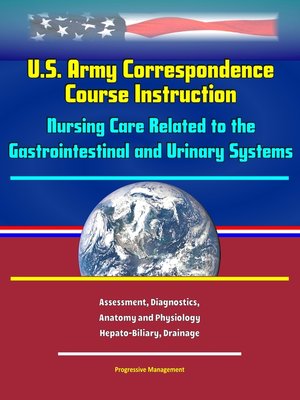U.S. Army Correspondence Course Instruction
ebook ∣ Nursing Care Related to the Gastrointestinal and Urinary Systems--Assessment, Diagnostics, Anatomy and Physiology, Hepato-Biliary, Drainage
By Progressive Management

Sign up to save your library
With an OverDrive account, you can save your favorite libraries for at-a-glance information about availability. Find out more about OverDrive accounts.
Find this title in Libby, the library reading app by OverDrive.



Search for a digital library with this title
Title found at these libraries:
| Loading... |
Professionally converted for accurate flowing-text e-book format reproduction, this is a reproduction of a U.S. Army Correspondence Course instruction: Nursing Care Related to the Gastrointestinal and Urinary Systems
Contents: Chapter 1 - Nursing Care Related To The Gastrointestinal System - Section I. Anatomy and Physiology, Section II. Nursing Assessment, Section III. Diagnostic Procedures, Section IV. Gastrointestinal Intubation, Section V. Gastrostomy, Colostomy, Ileostomy, Section VI. Gastrointestinal Disorders, Section VII. Hepato-Biliary Disorders, Section VIII. Diabetes. Exercises * Chapter 2 - Nursing Care Related To The Urinary System - Section I. Anatomy and Physiology, Section II. Nursing Assessment and Diagnostic Procedures, Section III. Catheterization and Drainage, Section IV. Urinary Disorders. Exercises
A patient is not a passive object on which we perform nursing care procedures. A patient should never be thought of, or discussed, as merely a condition or injury. It is not acceptable to think of, or refer to, your patient as "the gallbladder" or "the fractured hip" or "the bleeding ulcer." A patient is much more than the condition that brought him to the hospital. A patient is a human being, possessing physical and emotional needs and wants. The relationship between the patient and the nursing staff is extremely dynamic and personal. The patient places his trust in the nursing staff and they, in return, must utilize all their knowledge and skills to ensure the patient's well-being and assist in his return to good health and independence. This is accomplished by developing a therapeutic relationship between the patient, his family, and the health care professionals. The nursing paraprofessional relates very closely with the patient and his family by virtue of his participation in providing nursing care and his presence at the bedside. It is often the nursing paraprofessional who makes the initial observation that something is not as it should be. Nursing paraprofessionals who are responsible, educated, and observant are assets to the therapeutic environment necessary for patient recovery.






